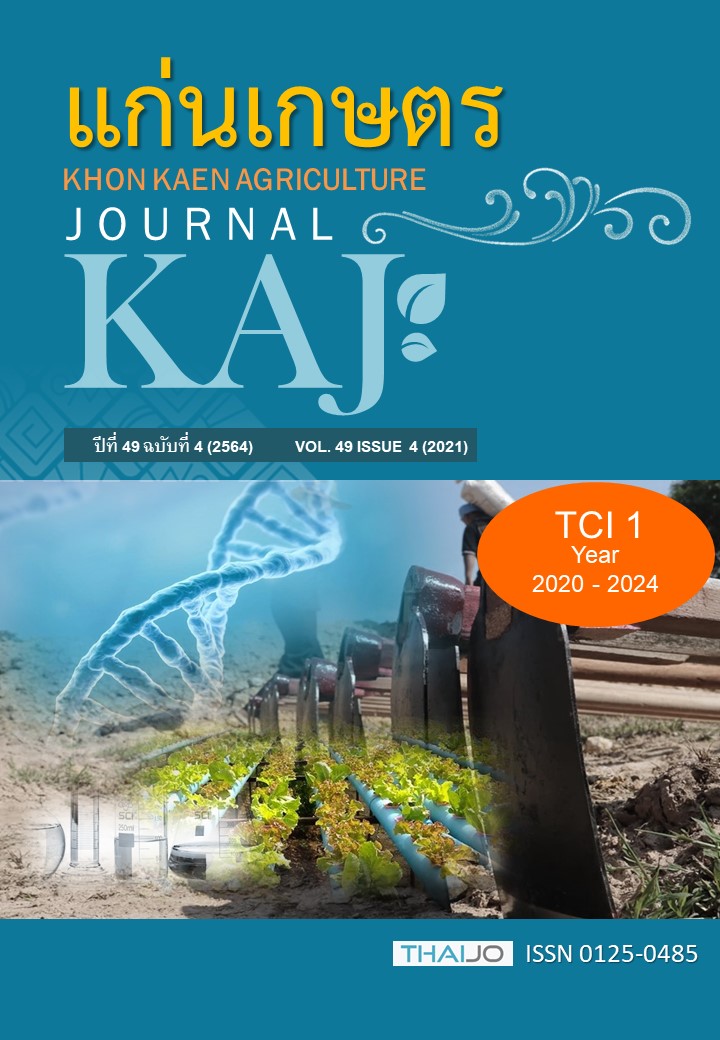ผลของระดับโปรตีนในอาหารผสมครบส่วนต่อสมรรถภาพการเจริญเติบโตของแกะขนในพื้นที่สถานีเกษตรหลวงอินทนนท์
Main Article Content
บทคัดย่อ
วัตถุประสงค์การวิจัยครั้งนี้เพื่อประเมินสมรรถภาพการเจริญติบโตของแกะขนในพื้นที่สถานีเกษตรหลวงอินทนนท์ ที่ได้รับอาหารที่ระดับโปรตีนแตกต่างกัน โดยวางแผนการทดลองแบบสุ่มสมบูรณ์ แบ่งอาหารทดลองออกเป็น 3 กลุ่ม ได้แก่ กลุ่มที่ 1 อาหารผสมครบส่วนที่ระดับโปรตีน 14% (14%CP TMR) กลุ่มที่ 2 อาหารผสมครบส่วนที่ระดับโปรตีน 16% (16%CP TMR ) และกลุ่มที่ 3 อาหารผสมครบส่วนที่ระดับโปรตีน 18% (18%CP TMR) สุ่มเก็บตัวอย่างอาหารผสมครบส่วนเพื่อวิเคราะห์องค์ประกอบทางเคมี โดยวิธีแบบประมาณ และการวิเคราะห์ปริมาณเยื่อใยโดยใช้สารฟอก สำหรับการศึกษาสมรรถภาพการเจริญติบโตใช้แกะขน อายุเริ่มต้นเฉลี่ย 264 ± 9 วัน จำนวน 24 ตัว น้ำหนักเริ่มต้นเฉลี่ย 26.22 ± 3.24 กิโลกรัม บันทึกปริมาณการกินได้ อัตราการเจริญเติบโต น้ำหนักตัวที่เพิ่มขึ้น ประสิทธิภาพการเปลี่ยนอาหารเป็นน้ำหนักตัว ประสิทธิภาพการใช้โปรตีน และต้นทุนค่าอาหารต่อการเปลี่ยนเป็นน้ำหนักตัวของแกะขน เป็นระยะเวลา 3 เดือน ผลการศึกษาพบว่า แกะขนที่ได้รับอาหารผสมครบส่วนที่ระดับโปรตีน 14, 16 และ 18% มีน้ำหนักที่เพิ่มขึ้น (BWG) อัตราการเจริญเติบโต (ADG) และอัตราการเปลี่ยนอาหารเป็นน้ำหนักตัว (FCR) ไม่แตกต่างกัน (P>0.05) อย่างไรก็ตาม แกะขนที่ได้รับอาหารผสมครบส่วนที่ระดับโปรตีน 14% มีต้นทุนค่าอาหารและต้นทุนค่าอาหารต่อการเปลี่ยนเป็นน้ำหนักตัว (FCG) ต่ำที่สุด ดังนั้นอาหารผสมครบส่วนที่ระดับโปรตีน 14% จึงมีความเหมาะสมต่อสมรรถภาพการเจริญติบโตของแกะขนมากที่สุด
Article Details

อนุญาตภายใต้เงื่อนไข Creative Commons Attribution-NonCommercial-NoDerivatives 4.0 International License.
เอกสารอ้างอิง
Crook, B.J., R.A. Farrell, R.S. Hegarty, and I.W. Purvis. 2000. Dietary Protein and the Discolouration of Wool from Superfine Merino sheep. Asian-Australasian Journal of Animal Sciences. 13(Suppl. C):164-167
Dabiri, N., and M.L. Thonney. 2004. Source and level of supplemental protein for growing lambs. Journal of Animal Science. 82: 3237-3244.
Estra-Angulo, A., B.I. Castro-Péreza, J.D. Urías-Estrada, F.G. Ríos-Rincón, Y.J. Arteaga-Wences, A. Barreras, M.A. López-Soto, A. Plascencia, and R.A. Zinn. 2018. Influence of protein level on growth performance, dietary energetics and carcass characteristics of Pelibuey×Katahdin lambs finished with isocaloric diets. Small Ruminant Research. 160: 59-64.
Haddad, S.G., R.E. Nasr, and M.M. Muwalla. 2001. Optimum dietary crude protein level for finishing Awassi lambs. Small Ruminant Research. 39: 41-46.
Javaid, A., Mahr-un-Nisa, M. Sarwar, and M.A. Shahzad. 2008. Ruminal characteristics, blood pH, blood urea nitrogen and nitrogen balancein Nili-Ravi buffalo (Bubalus bubalis) bulls fed diets containing various levels of ruminally degradable protein. Asian-Australasian Journal of Animal Sciences. 21: 51–59.
Wunjan, J, S. Yammuen-art, and T. Moonmanee. 2019. Effects of protein levels in total mixed rations on productive performance of male dairy goats. Khon Kaen Agriculture Journal. 47 (Suppl. 2) : 742 – 746. ( In Thai)
Kaya, I., Y. Unal, T. Sahin, and D. Elmali. 2009. Effect of different protein levels on fattening performance, digestibility and rumen parameters in finishing lambs. Journal of Animal and Veterinary Advances. 8: 309-312.
NRC. 1985. Nutrient Requirement of Sheep. 6th ed. National Academy Press, Washington, DC.
Poser, H., L Semplicini., GM De Benedictis,, G. Gerardi, B Contiero, N. Maschietto, E. Valerio O. Milanesi, A. Semplicini, and D. Bernardini. 2013. Two-dimensional, M-mode and Doppler-derived echocardiographic parameters in sedated healthy growing female sheep. Lab Animal. 47(3): 194-202
Steel, R.G.D., and J.H. Torrie. 1980. Principles and Procedures of Statistics. A Biometrical Approach. 2nd Edition. M.C. Graw-Hill Book Co., New York.
Sultan, J.I., A. Javaid, and M. Aslam. 2010. Nutrient digestibility and feedlot performance of lambs fed diets varying protein and energy content. Tropical Animal Health and Production. 42: 941-946.
Zinn, R.A., and Y Shen. 1998. An evaluation of ruminally degradable intake protein and metabolizable amino acid requirements of feedlot calves. Journal of Animal Science.76: 1280-1289.


